oil pressure MERCEDES-BENZ E320 2000 W210 Owner's Manual
[x] Cancel search | Manufacturer: MERCEDES-BENZ, Model Year: 2000, Model line: E320, Model: MERCEDES-BENZ E320 2000 W210Pages: 341, PDF Size: 15.07 MB
Page 7 of 341

4 Contents
AIRBAG OFF
indicator lamp .............................238
Malfunction and warning
messages in the
multifunction display ...............239
DISPLAY DEFECTIVE ................240
BATTERY / ALTERNATOR ......... 241
ABS-SYSTEM ...............................242
BRAKE ASSIST ...........................242
BRAKE LINING WEAR ..............243
BRAKE FLUID .............................243
PARKING BRAKE .......................244
ENGINE FAN ...............................244
COOLANT (coolant level) ..........245
COOLANT TEMP. ........................246
LIGHTING SYSTEM ....................247
LIGHT SENSOR ...........................248
REMOVE KEY .............................248
TELE AID .....................................249
STEERING GEAR OIL .................249
ENGINE OIL LEVEL ...................250
WASHER FLUID .......................... 251
ELEC. STABIL. PROG.
(Electronic stability program) ..252
Practical hintsFirst aid kit ..................................... 254
Stowing things in the vehicle ...... 254
Fuses ............................................... 255
Hood ................................................ 257
Checking engine oil level ............. 260
Automatic transmission
fluid level ................................... 261
Coolant level ................................... 261
Adding coolant ........................... 262
Windshield and headlamp
washer system .......................... 263
Windshield and headlamp
washer fluid mixing ratio ........ 263
Spare wheel, vehicle tools,
storage compartment ............... 264
Vehicle jack .................................... 265
Wheels ............................................ 266
Tire replacement ....................... 266
Rotating wheels ......................... 267
Spare wheel .................................... 268
Spare wheel bolts ...................... 268
Spare wheel .................................... 269Changing wheels ........................... 271
Tire inflation pressure .................. 276
Battery .............................................277
Jump starting ..................................279
Towing the vehicle .........................282
Transmission selector lever,
manually unlocking ..................284
Exterior lamps ................................285
Headlamp assembly ...................286
Taillamp assemblies ..................289
Changing batteries in the
electronic main key .................. 291
Synchronizing
remote control ............................293
Emergency engine
shut-down ..................................293
Rear seat cushion ..........................294
Emergency operation of
sliding / pop-up roof .................295
Manual release for
fuel filler flap .............................296
Replacing wiper blade insert .......296
Trunk lamp .....................................298
Roof rack .........................................298
Page 233 of 341
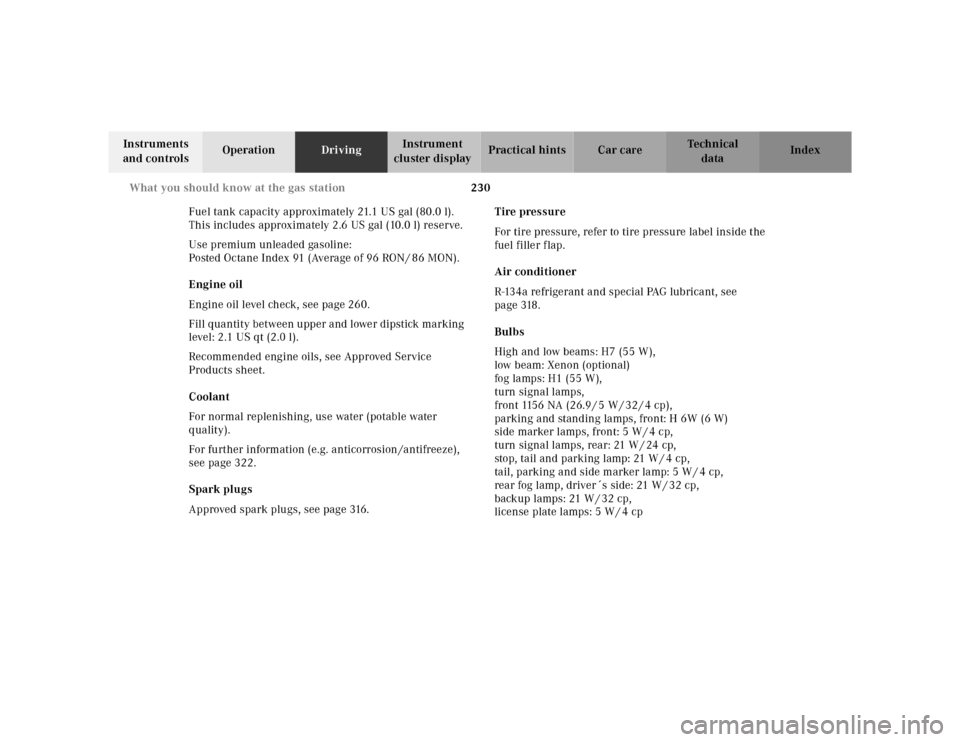
230 What you should know at the gas station
Te ch n ica l
data Instruments
and controlsOperationDrivingInstrument
cluster displayPractical hints Car care Index
Fuel tank capacity approximately 21.1 US gal (80.0 l).
This includes approximately 2.6 US gal (10.0 l) reserve.
Use premium unleaded gasoline:
Posted Octane Index 91 (Average of 96 RON / 86 MON).
Engine oil
Engine oil level check, see page 260.
Fill quantity between upper and lower dipstick marking
level: 2.1 US qt (2.0 l).
Recommended engine oils, see Approved Service
Products sheet.
Coolant
For normal replenishing, use water (potable water
quality).
For further information (e.g. anticorrosion /antifreeze),
see page 322.
Spark plugs
Approved spark plugs, see page 316.Tire pressure
For tire pressure, refer to tire pressure label inside the
fuel filler flap.
Air conditioner
R-134a refrigerant and special PAG lubricant, see
page 318.
Bulbs
High and low beams: H7 (55 W),
low beam: Xenon (optional)
fog lamps: H1 (55 W),
turn signal lamps,
front 1156 NA (26.9 / 5 W / 32 / 4 cp),
parking and standing lamps, front: H 6W (6 W)
side marker lamps, front: 5 W / 4 cp,
turn signal lamps, rear: 21 W / 24 cp,
stop, tail and parking lamp: 21 W / 4 cp,
tail, parking and side marker lamp: 5 W / 4 cp,
rear fog lamp, driver´s side: 21 W / 32 cp,
backup lamps: 21 W / 32 cp,
license plate lamps: 5 W / 4 cp
Page 256 of 341
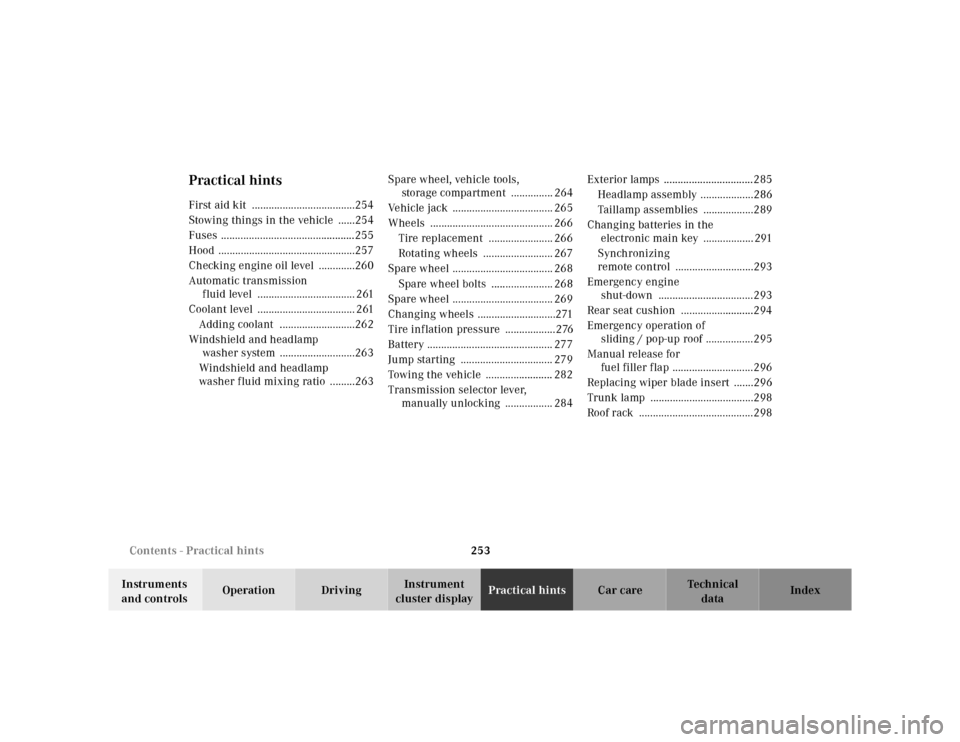
253 Contents - Practical hints
Te ch n ica l
data Instruments
and controlsOperation DrivingInstrument
cluster displayPractical hintsCar care Index
Practical hintsFirst aid kit .....................................254
Stowing things in the vehicle ......254
Fuses ................................................255
Hood .................................................257
Checking engine oil level .............260
Automatic transmission
fluid level ................................... 261
Coolant level ................................... 261
Adding coolant ...........................262
Windshield and headlamp
washer system ...........................263
Windshield and headlamp
washer fluid mixing ratio .........263Spare wheel, vehicle tools,
storage compartment ............... 264
Vehicle jack .................................... 265
Wheels ............................................ 266
Tire replacement ....................... 266
Rotating wheels ......................... 267
Spare wheel .................................... 268
Spare wheel bolts ...................... 268
Spare wheel .................................... 269
Changing wheels ............................271
Tire inflation pressure ..................276
Battery ............................................. 277
Jump starting ................................. 279
Towing the vehicle ........................ 282
Transmission selector lever,
manually unlocking ................. 284Exterior lamps ................................285
Headlamp assembly ...................286
Taillamp assemblies ..................289
Changing batteries in the
electronic main key .................. 291
Synchronizing
remote control ............................293
Emergency engine
shut-down ..................................293
Rear seat cushion ..........................294
Emergency operation of
sliding / pop-up roof .................295
Manual release for
fuel filler flap .............................296
Replacing wiper blade insert .......296
Trunk lamp .....................................298
Roof rack .........................................298
Page 278 of 341
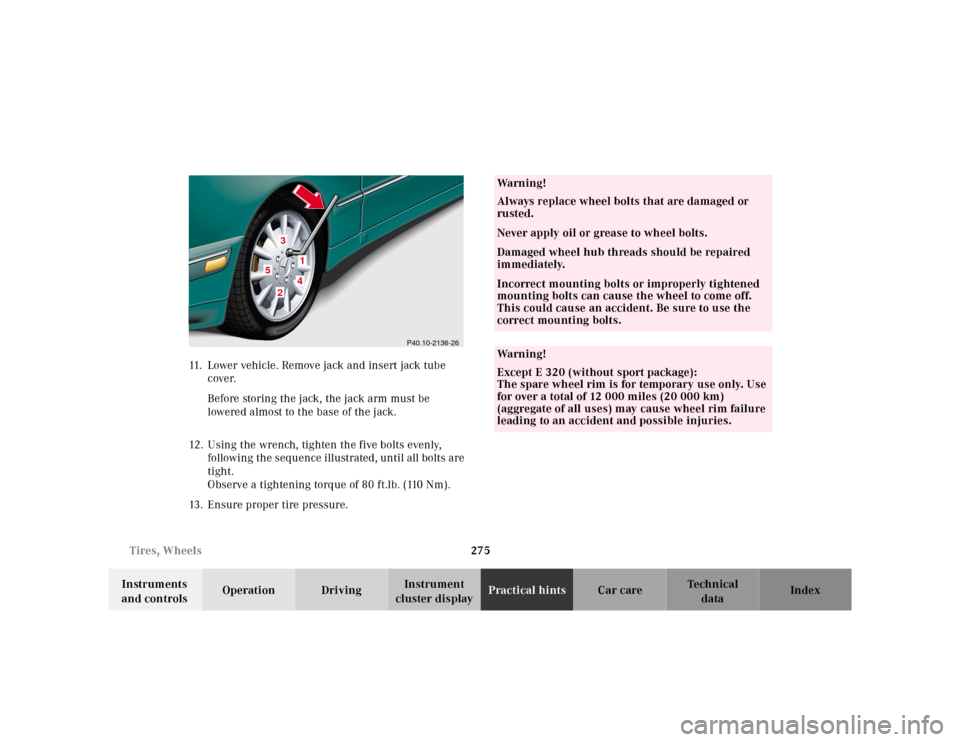
275 Tires, Wheels
Te ch n ica l
data Instruments
and controlsOperation DrivingInstrument
cluster displayPractical hintsCar care Index 11. Lower vehicle. Remove jack and insert jack tube
cover.
Before storing the jack, the jack arm must be
lowered almost to the base of the jack.
12. Using the wrench, tighten the five bolts evenly,
following the sequence illustrated, until all bolts are
tight.
Observe a tightening torque of 80 ft.lb. (110 Nm).
13. Ensure proper tire pressure.
P40.10-2136-26
32
41
5
Wa r n i n g !
Always replace wheel bolts that are damaged or
rusted.Never apply oil or grease to wheel bolts.Damaged wheel hub threads should be repaired
immediately.Incorrect mounting bolts or improperly tightened
mounting bolts can cause the wheel to come off.
This could cause an accident. Be sure to use the
correct mounting bolts.Wa r n i n g !
Except E 320 (without sport package):
The spare wheel rim is for temporary use only. Use
for over a total of 12 000 miles (20 000 km)
(aggregate of all uses) may cause wheel rim failure
leading to an accident and possible injuries.
Page 308 of 341
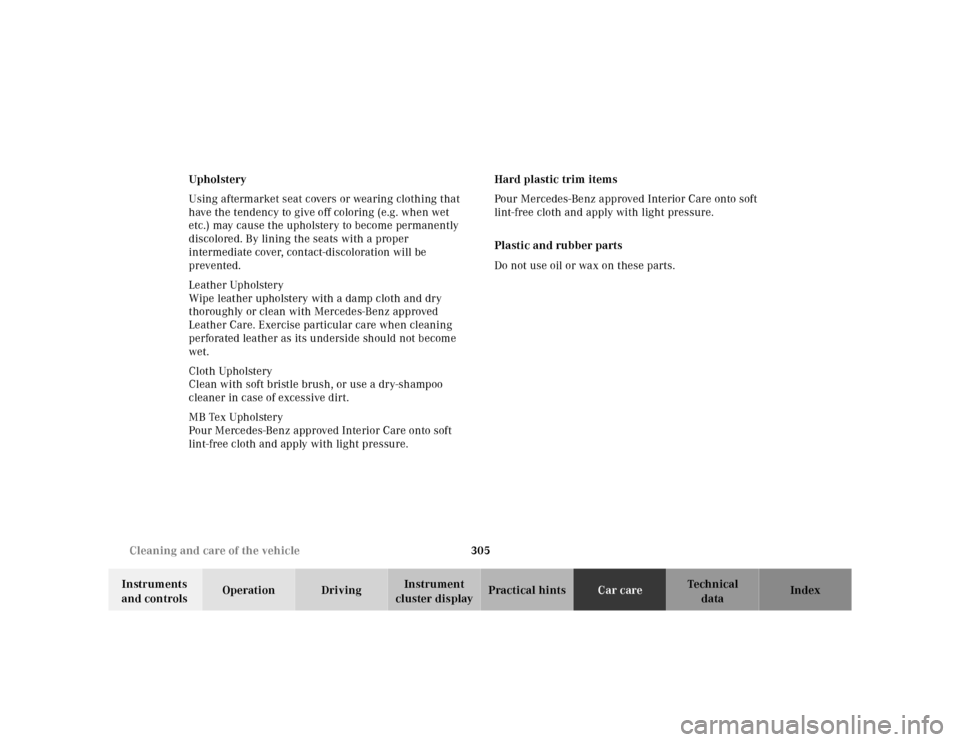
305 Cleaning and care of the vehicle
Te ch n ica l
data Instruments
and controlsOperation DrivingInstrument
cluster displayPractical hintsCar careIndex Upholstery
Using aftermarket seat covers or wearing clothing that
have the tendency to give off coloring (e.g. when wet
etc.) may cause the upholstery to become permanently
discolored. By lining the seats with a proper
intermediate cover, contact-discoloration will be
prevented.
Leather Upholstery
Wipe leather upholstery with a damp cloth and dry
thoroughly or clean with Mercedes-Benz approved
Leather Care. Exercise particular care when cleaning
perforated leather as its underside should not become
wet.
Cloth Upholstery
Clean with soft bristle brush, or use a dry-shampoo
cleaner in case of excessive dirt.
MB Tex Upholstery
Pour Mercedes-Benz approved Interior Care onto soft
lint-free cloth and apply with light pressure.Hard plastic trim items
Pour Mercedes-Benz approved Interior Care onto soft
lint-free cloth and apply with light pressure.
Plastic and rubber parts
Do not use oil or wax on these parts.
Page 324 of 341
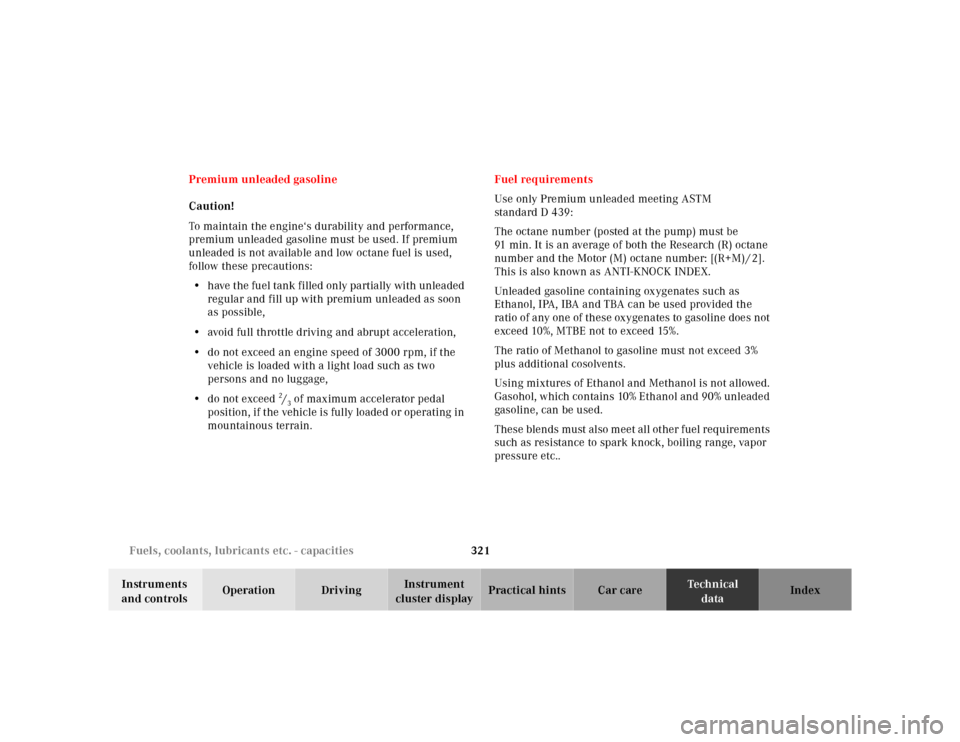
321 Fuels, coolants, lubricants etc. - capacities
Te ch n ica l
data Instruments
and controlsOperation DrivingInstrument
cluster displayPractical hints Car care Index Premium unleaded gasoline
Caution!
To maintain the engine‘s durability and performance,
premium unleaded gasoline must be used. If premium
unleaded is not available and low octane fuel is used,
follow these precautions:
•have the fuel tank filled only partially with unleaded
regular and fill up with premium unleaded as soon
as possible,
•avoid full throttle driving and abrupt acceleration,
•do not exceed an engine speed of 3000 rpm, if the
vehicle is loaded with a light load such as two
persons and no luggage,
•do not exceed
2/3 of maximum accelerator pedal
position, if the vehicle is fully loaded or operating in
mountainous terrain.Fuel requirements
Use only Premium unleaded meeting ASTM
standard D 439:
The octane number (posted at the pump) must be
91 min. It is an average of both the Research (R) octane
number and the Motor (M) octane number: [(R+M) / 2].
This is also known as ANTI-KNOCK INDEX.
Unleaded gasoline containing oxygenates such as
Ethanol, IPA, IBA and TBA can be used provided the
ratio of any one of these oxygenates to gasoline does not
exceed 10%, MTBE not to exceed 15%.
The ratio of Methanol to gasoline must not exceed 3%
plus additional cosolvents.
Using mixtures of Ethanol and Methanol is not allowed.
Gasohol, which contains 10% Ethanol and 90% unleaded
gasoline, can be used.
These blends must also meet all other fuel requirements
such as resistance to spark knock, boiling range, vapor
pressure etc..
Page 338 of 341
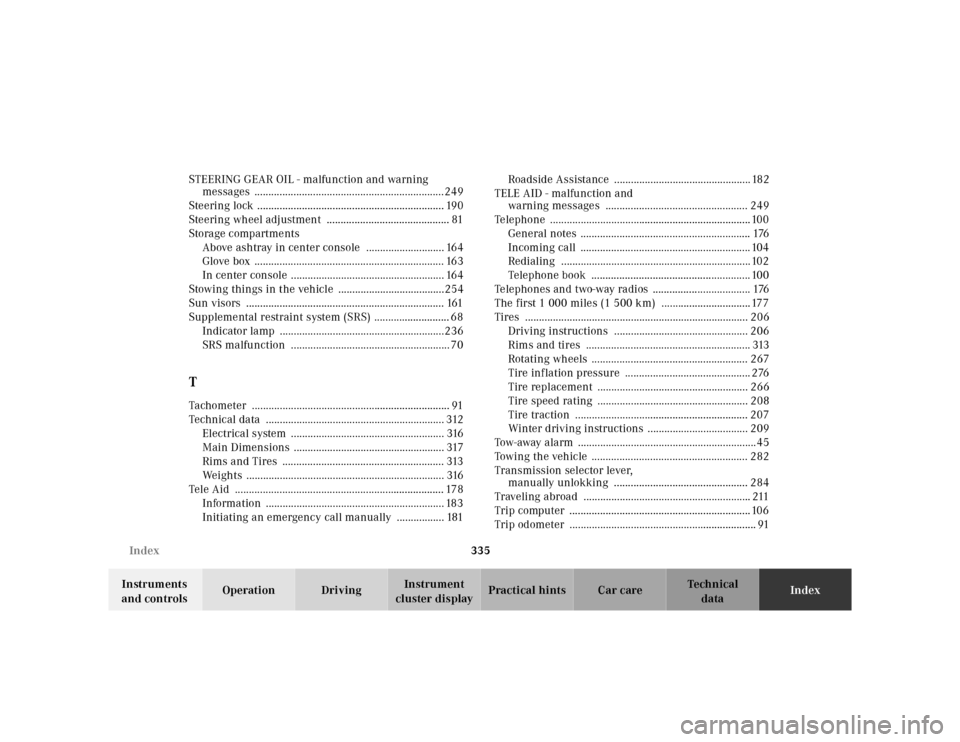
335 Index
Te ch n ica l
data Instruments
and controlsOperation DrivingInstrument
cluster displayPractical hints Car careIndex STEERING GEAR OIL - malfunction and warning
messages ....................................................................249
Steering lock ................................................................... 190
Steering wheel adjustment ............................................ 81
Storage compartments
Above ashtray in center console ............................ 164
Glove box .................................................................... 163
In center console ....................................................... 164
Stowing things in the vehicle ......................................254
Sun visors ....................................................................... 161
Supplemental restraint system (SRS) ........................... 68
Indicator lamp ...........................................................236
SRS malfunction ......................................................... 70
TTachometer ....................................................................... 91
Technical data ................................................................ 312
Electrical system ....................................................... 316
Main Dimensions ...................................................... 317
Rims and Tires .......................................................... 313
Weights ....................................................................... 316
Tele Aid ........................................................................... 178
Information ................................................................ 183
Initiating an emergency call manually ................. 181Roadside Assistance ................................................. 182
TELE AID - malfunction and
warning messages ................................................... 249
Telephone ........................................................................100
General notes ............................................................. 176
Incoming call ............................................................. 104
Redialing ....................................................................102
Telephone book ......................................................... 100
Telephones and two-way radios ................................... 176
The first 1 000 miles (1 500 km) ................................177
Tires ................................................................................ 206
Driving instructions ................................................ 206
Rims and tires ........................................................... 313
Rotating wheels ........................................................ 267
Tire inflation pressure ............................................. 276
Tire replacement ...................................................... 266
Tire speed rating ...................................................... 208
Tire traction .............................................................. 207
Winter driving instructions .................................... 209
Tow-away alarm ................................................................45
Towing the vehicle ........................................................ 282
Transmission selector lever,
manually unlokking ................................................ 284
Traveling abroad ............................................................ 211
Trip computer .................................................................106
Trip odometer ................................................................... 91